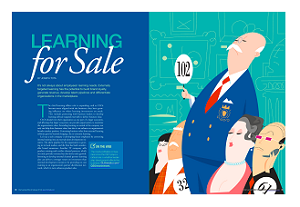Posted by Caveo Learning ● January 21, 2015
External Learning Can Result in Revenue, Loyalty, Differentiation
 When the topic of externally targeted learning arises, it's often in the context of converting the learning and development organization into a profit center by selling materials and expertise. While revenue generation is certainly a major aspect of external learning, it also has the potential to build brand loyalty, develop talent pipelines, and differentiate organizations in the marketplace.
When the topic of externally targeted learning arises, it's often in the context of converting the learning and development organization into a profit center by selling materials and expertise. While revenue generation is certainly a major aspect of external learning, it also has the potential to build brand loyalty, develop talent pipelines, and differentiate organizations in the marketplace.
In the February 2015 issue of Chief Learning Officer magazine, Caveo Learning Strategic Learning Partner Joseph Tota examines how the value of extending learning outside an organzation can go way beyond being a simple revenue stream.
For Rackspace, the managed cloud company, the implementation of its public-facing Open Cloud Academy serves the dual purposes of growing Rackspace's brand awareness and creating a pool of qualified local applicants. Rackspace charges tuition to cover the costs of the entry-level curriculum, but revenue is not the point—it's the 60% hire rate for program graduates.
Some companies may even consider offering external training solutions for little or no cost, as a way to entice a bulk product sale or to engender brand loyalty. This strategy of external learning bundling, seen in the tech industry and elsewhere, can help boost user adoption by making the product easier to use and master.
Here are 4 primary considerations when exploring how best to package external learning.
- Identify a business need. This involves asking standard strategic questions about business objectives and product opportunities.
- Analyze internal and external stakeholders. It's important to understand whether business partners will support the initiative, and what risks and obstacles may crop up.
- Develop a learning strategy. This is the roadmap to creating, implementing, and sustaining any external learning initiative.
- Manage risk. All business initiatives involve risk, but there are some acute concerns when it comes to distributing learning externally. Namely, it's critical to avoid inadvertantly disseminating proprietary information that could neutralize competitive advantage, or otherwise expose confidential data or business strategy.
Ultimately, any decision to engage in external learning must make sense within the goals of the organization, and defining that alignment is a helpful step before pitching the program to key business leaders.
Click here to read Joseph Tota's article, "Learning for Sale," in Chief Learning Officer magazine.
Topics: Metrics & Measurement, Managed Services, Learning Trends
